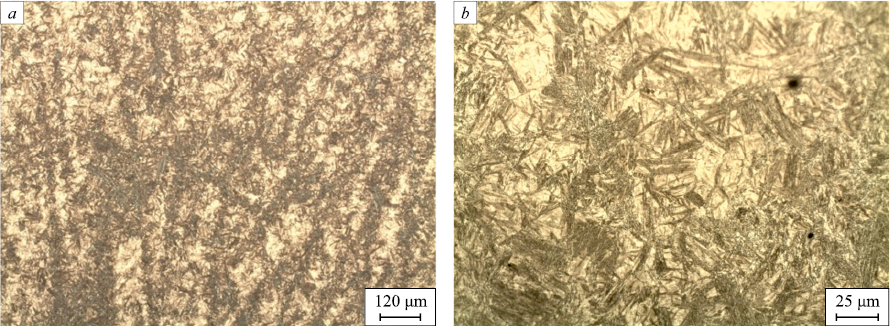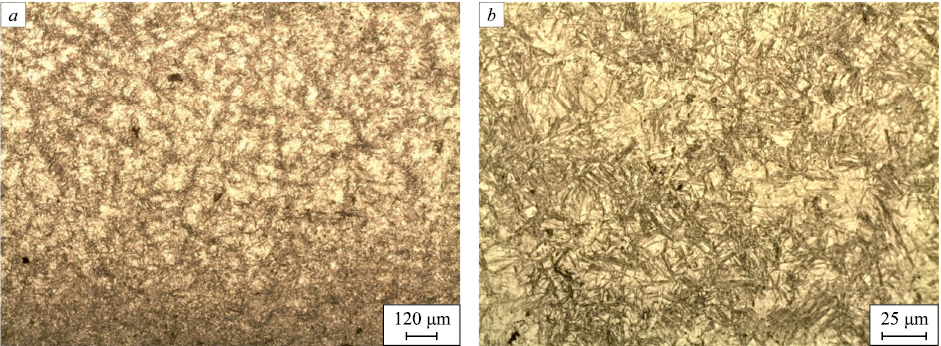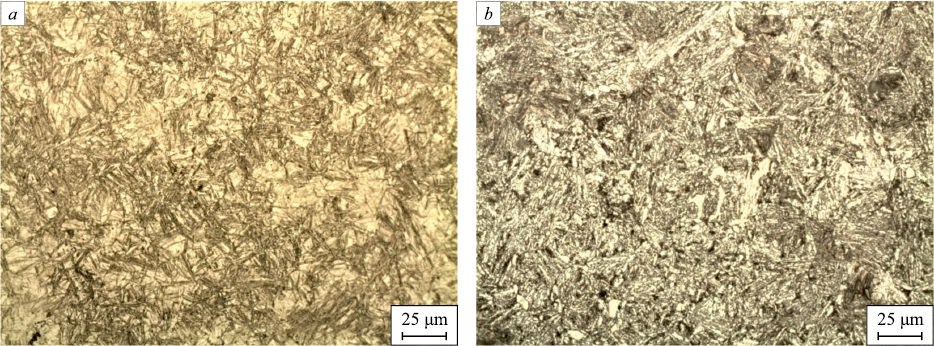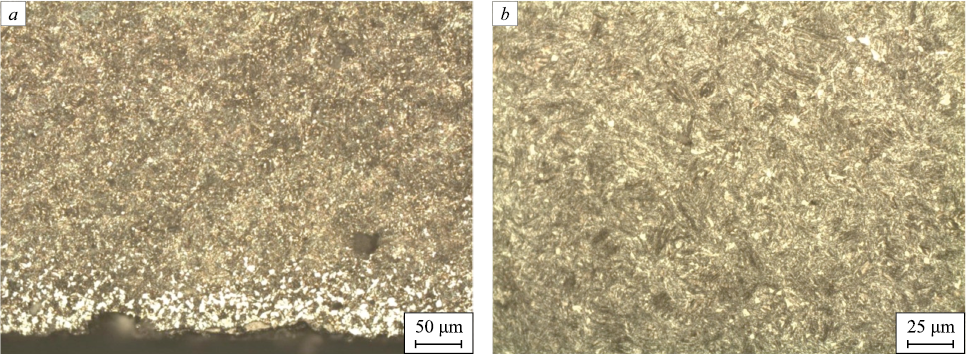Scroll to:
Experience in producing rails from bainitic steels 30KhG2S2АFM and 30KhG2SАFN
https://doi.org/10.17073/0368-0797-2025-2-124-130
Abstract
The operational resistance of railway rails is mainly determined by the resistance to contact fatigue defects and wear resistance, and, in addition to the impact characteristics of rolling stock wheels, depends on the chemical composition, structure and mechanical properties of rail steel. Currently, the ways to improve the operational properties of traditional pearlitic rails by increasing the microstructure dispersion are almost exhausted. One of the solutions to increase the service life of rails may be the transition to their production from bainitic steels, characterized by higher mechanical properties, resistance to the formation of surface contact and fatigue defects and increased cold resistance. Operational tests conducted abroad in the early 2000s showed that rails made of bainitic steel do indeed have increased resistance to formation of contact fatigue defects compared to rails made of pearlitic steel, but they are subject to more intensive wear. It was concluded that the resistance of bainitic rails to head damage by surface contact and fatigue defects is a consequence of the removal of the damaged rolling surface layer as a result of wear. In 2004 – 2006, JSC EVRAZ United West Siberian Metallurgical Plant conducted research and produced an experimental batch of bainitic rails, which showed the promise of using such steel and the possibility of simultaneously providing increased wear resistance and low-temperature reliability. However, at that time, the plant did not have the full capabilities to ensure the high metallurgical quality of steel: the identified shortcomings are related to the insufficient purity of the metal for non-metallic inclusions. As part of the resumption of work on the development of bainitic rails, two experimental medium-carbon steels B1 and B2, differing in alloying schemes, were smelted, rolled onto rails of type P65 and cooled in calm air. The presented results of mechanical tests showed the positive effect of increased chromium and nickel alloying on mechanical properties and structure.
Keywords
For citations:
Yunusov A.M., Polevoi E.V., Yunin G.N., Oskolkova T.N. Experience in producing rails from bainitic steels 30KhG2S2АFM and 30KhG2SАFN. Izvestiya. Ferrous Metallurgy. 2025;68(2):124-130. https://doi.org/10.17073/0368-0797-2025-2-124-130
Introduction
As is well known [1 – 3], the service life of railway rails is influenced by numerous technological and operational factors. Among the latter, the most critical – judging by the number of rails removed due to defects or severe damage – are the resistance of rail steel to contact fatigue defects and its wear resistance. These properties, in turn, depend largely on technological parameters such as chemical composition, microstructure, mechanical properties, the level of non-metallic inclusions, and the magnitude and distribution of residual stresses.
Traditionally [4], rail steels have a high carbon content (0.6 – 0.8 wt. %) and a pearlitic microstructure. Improvements in the wear resistance of pearlitic steels have been achieved by optimizing both chemical composition and heat treatment parameters, which allow for a reduction in the interlamellar spacing of cementite plates within pearlite colonies. This refinement enhances the strength, ductility, and hardness of the steel.
In modern pearlitic rail steels, the interlamellar spacing has reached its theoretical lower limit [5], estimated at 0.06 – 0.07 μm. Therefore, further improvements in the performance of pearlitic rails appear to be nearly exhausted. A promising alternative is the production of rails from bainitic steels, which feature a finer microstructure and, as a result, offer superior mechanical properties and increased resistance to contact fatigue defect (CFD) formation.
In the late 1990s and early 2000s, with support from railways in Western Europe and the United States, several experimental bainitic steel grades suitable for manufacturing heat-treated rails were developed by metallurgical institutes and industrial enterprises [6 – 10].
Initial field trials of hot-rolled rails made from B360 bainitic steel, conducted near Frick Station in Switzerland in 1999, confirmed that this material offers significantly improved resistance to the initiation and growth of contact fatigue defects [8].
However, some bainitic rail grades have shown more intensive wear compared to the widely used heat-treated pearlitic rails. According to studies conducted by the Materials and Processing Research Center (NKK Corporation, Japan), the wear resistance of pearlitic steels is primarily determined by their hardness and microstructural characteristics. It has been concluded in [10; 11] that the high resistance of bainitic rails to contact fatigue damage is due to the gradual removal of the surface layer affected by rolling contact – a phenomenon referred to as the so-called “magic grinding effect”.
These findings suggest that bainitic rails require further investigation before they can be considered a reliable alternative to heat-treated pearlitic rails [7].
Materials and research results
Studies conducted at EVRAZ United West Siberian Metallurgical Plant (EVRAZ ZSMK) between 2004 and 2006 demonstrated that a lower bainite microstructure – typically used in critical structural applications requiring high strength – can be obtained in rails made from medium-carbon steel alloyed with chromium, molybdenum, nickel, and vanadium [12; 13]. Test results for experimental rails after rolling, normalizing, and tempering confirmed the potential of using such steel to simultaneously achieve enhanced wear resistance and improved low-temperature reliability. Field testing of an experimental batch of bainitic rails produced in 2005 by the EVRAZ Novokuznetsk Metallurgical Plant using E30KhG2SAFM steel showed promising results, provided that further improvements in steel purity – specifically with respect to non-metallic inclusions – could be achieved. At the time, however, the plant did not yet have the full technical capabilities to ensure consistently high metallurgical quality and precision rolling using modern equipment. In light of increasingly stringent performance requirements for rails operating under the extremely harsh conditions of the Eastern Railway Network – characterized by prolonged exposure to very low temperatures – it has become necessary to develop a new bainitic steel composition and define a suitable production route, taking into account the current capabilities of the modernized rail manufacturing facilities.
In 2022, EVRAZ ZSMK resumed the development of bainitic rail steel production technology aimed at meeting modern operational demands. Two pilot heats with improved chemical compositions were produced. Rolling was carried out in the rail and beam shop using the plant’s standard process flow, with the use of a tandem universal mill and a separate finishing stand. Complete cooling of the experimental rolled products was carried out in bundles on a cooling bed, in still air, without forced convection.
Two medium-carbon steels, provisionally designated B1 and B2, were tested. Steel B1 featured a higher content of molybdenum and silicon, while steel B2 was characterized by increased levels of chromium and nickel (Table 1). For comparison, the chemical composition of the E30KhG2SAFM bainitic steel grade produced in 2004 is also provided [13].
Table 1. Chemical composition of the studied steels
| ||||||||||||||||||||||||||||||||||
The chemical compositions of the experimental grades differ considerably in their silicon, chromium, nickel, and molybdenum content. Compared to E30KhG2SAFM, steel B1 has a higher silicon content and slightly elevated levels of chromium and molybdenum.
To determine the mechanical properties of the rails, tensile tests were carried out using cylindrical specimens with a diameter of 6 mm and a gauge length of 30 mm (Type III, GOST 1497–84). Impact bending tests were performed at +20 °C and –60 °C using U-notch specimens (Type I, GOST 9454–78), in accordance with GOST standards for impact strength. Hardness was measured both on the running surface and across the cross-section of the rail head.
The results of the mechanical tests (Table 2) show that, compared to rails made from B1 steel, rails made from B2 steel exhibit higher strength properties: yield strength is 20 % higher, and ultimate tensile strength is 9.2 % higher. However, B2 steel has a 27 % lower elongation at fracture, while the values of area reduction are similar for both steels.
Table 2. Mechanical properties of bainitic steel rails
| |||||||||||||||||||||||||||||||||||||||||
At +20 °C, the impact strength values of the two steels are fairly close. However, at –60 °C, the B2 steel demonstrates a significantly higher impact strength – 48 % higher than that of B1 steel. These results indicate a positive effect of nickel on impact strength at sub-zero temperatures.
Compared to rails made from E30KhG2SAFM steel, the B1 steel rails show higher strength properties (yield strength is 9.6 % higher, and tensile strength is 10.1 % higher), although their elongation is somewhat lower (by 9.4 %) at comparable values of area reduction. It is worth noting that the impact strength of B1 steel rails is significantly higher than that of E30KhG2SAFM rails. This improvement is attributed to the higher purity of the steel in terms of trace elements and non-metallic inclusions, as well as better structural refinement achieved through processing in the universal rail rolling mill.
The hardness distribution across the cross-sections of the experimental rails is presented in Table 3.
Table 3. Hardness on the head rolling surface and on the cross section
| |||||||||||||||||||||||||||||||||||||||||||||||||||
Rails made from B2 steel generally exhibit higher hardness compared to those made from B1 steel, which is attributed to differences in the overall level of alloying. Notably high hardness was also recorded in the foot fillet regions of both steel grades. This is primarily due to the increased cooling rate in these areas, resulting from the thinner cross-sections of the rail profile. A similar hardness pattern was observed previously in rails made from E30KhG2SAFM steel.
Microstructural analysis conducted using an Olympus GX71 optical microscope revealed zones of structural heterogeneity in the rail head of B2 steel. These inhomogeneities were caused by uneven plastic deformation during rolling and appeared as alternating carbon-enriched and carbon-depleted regions. Upon cooling from rolling heat, martensitic transformation occurred in the carbon-rich zones, while bainitic structures formed in the carbon-depleted ones (Fig. 1). The combination of high strength, ductility, and toughness observed in the material is a result of this mixed microstructure. As the distance from the fillet surface increases, the proportion of bainite in the structure also grows, which is consistent with variations in the cooling rate across the rail head section.
Fig. 1. Microstructure of B2 steel rail head: |
The microstructure at the base of the B2 rail foot and in its fillets consists predominantly of martensite (Fig. 2). The formation of martensite in this region is associated with the relatively high cooling rate under still air conditions, which is intensified by the smaller cross-sectional area compared to the head.
Fig. 2. Microstructure of B2 steel rail foot: |
The microstructure of the B1 rail head is shown in Fig. 3. Near the fillet surface, a partially decarburized layer is visible, along with fine polygonal ferrite grains. The microstructure is predominantly composed of lower bainite exhibiting a needle-like morphology. As the depth increases, upper bainite begins to appear. This phase has a feathery morphology, comprising alternating fragmented ferrite and cementite plates. Beyond a depth of 20 mm, the structure transitions almost entirely to upper bainite.
Fig. 3. Microstructure of B1 steel rail head: |
The microstructures of the rail foot and fillet regions are shown in Fig. 4. In the foot, both lower and upper bainite are present (Fig. 4, a), while the fillet areas consist mainly of lower bainite with isolated regions of martensite (Fig. 4, b).
Fig. 4. Microstructure of the foot and foot fillets of rail: |
According to published studies [14 – 17], the most favorable microstructure for bainitic rail steels is a combination of lower bainite and lath martensite. This is because, during the transformation of austenite into lower bainite, retained austenite becomes segmented into thin regions by the bainitic laths. Subsequent martensitic transformation within these confined regions leads to the formation of an extremely fine lath martensite structure. The finer the microstructure, the greater the strength and toughness of the steel. Steels with this type of mixed structure exhibit both high ductility and fracture toughness. Moreover, as contact stress increases, the wear rate of such steels rises more slowly than that of pearlitic rail steels [10; 17 – 19].
The results of the study suggest that B2 steel is suitable for the production of rails cooled in still air after rolling. To improve processability – specifically, to facilitate straightening and reduce internal microstresses – it is recommended to test a reduced carbon content of 0.28 – 0.30 %, while maintaining the levels of the other alloying elements.
Conclusions
A comparative evaluation of the hot-rolled rail steel produced from experimental compositions B1 and B2 demonstrated that increased alloying with chromium (1.2 – 1.5 %) and nickel (1.0 – 1.1 %) leads to a 20 % increase in yield strength, a 9.2 % increase in ultimate tensile strength, and a 48 % increase in impact strength at –60 °C compared to the alloying scheme based on molybdenum at 0.20 – 0.30 %.
Microstructural analysis of the rails made from both experimental steel grades revealed the formation of needle-like upper and lower bainite during continuous cooling in still air. In the B2 steel rails, a higher fraction of martensite was observed in the head, which contributed to increased strength and hardness.
To further develop the technology and achieve a more stable structure consisting predominantly of lower bainite, it is recommended to use B2 steel as a base composition, while reducing the carbon content to 0.25 – 0.30 %.
References
1. Shur E.A. Rail Damage. Moscow: Intekst; 2012:192. (In Russ.).
2. Pavlov V.V., Godik L.A., Korneva L.V., Kozyrev N.A., Gizatulin R.A. Production of rails with increased wear resistance. Izvestiya. Ferrous Metallurgy. 2007;50(10):35–37. (In Russ.).
3. Ermakov V.M. About some issues of rail management. In: Improving the Quality and Operating Conditions of Rails and Rail Fasteners (based on the Materials of the Meeting of the Non-Profit Partnership “Rail Commission”, October 7–9, 2014): Proceedings. St. Petersburg: UIM; 2015:137–148. (In Russ.).
4. Pavlov V.V., Temlyantsev M.V., Korneva L.V., Syusyukin A.Yu. Promising Technologies of Thermal and Heat Treatment in Production of Rails. Moscow: Teplotekhnik; 2007:280. (In Russ.).
5. Korneva L.V., Yunin G.N., Kozyrev N.A., Atkonova O.P., Polevoi E.V. Comparative analysis of quality indicators of rails of JSC Novokuznetsk Metallurgical Plant and foreign manufacturers. Izvestiya. Ferrous Metallurgy. 2010;53(12):38–42. (In Russ.).
6. Hlavatý I., Sigmund M., Krejčí L., Mohyla P. The bainitic steels for rails applications. Materials Science Engineering. 2009;16(4):44–50.
7. Rail steel – evolution and prospects. Zheleznye dorogi mira. 2008;(5):59–64. (In Russ.).
8. Bainitic steel rails on Swiss railways. Zheleznye dorogi mira. 2011;(5):71–75. (In Russ.).
9. Pacyna J. The microstructure and properties of the new bainitic rail steels. Journal of Achievements in Materials and Manufacturing Engineering. 2008;28(1):19–22.
10. Yokoyama H., Mitao S., Yamamoto S., Kataoka Y., Sugiyama T. High strength bainitic steel rails for heavy haul railways with superior damage resistance. NKK Technical Review. 2001;(84):44–51.
11. Yokoyama H., Mitao S., Yamamoto S., Fujikake M. Effect of the angle of attack on flaking behavior in pearlitic and bainitic steel rails. Wear. 2002;253(1-2):60–66. https://doi.org/10.1016/S0043-1648(02)00083-2
12. Pavlov V.V., Godik L.A., Korneva L.V., Kozyrev N.A., Kuznetsov E.P. The railway rails from bainite steel. Metallurg. 2007;(4):51–53. (In Russ.).
13. Korneva L.V., Oskolkova T.N. Structure of bainitic steel rails. Izvestiya. Ferrous Metallurgy. 2006;49(12):26–27. (In Russ.).
14. Dobuzhskaya A.B., Galitsyn G.A., Smirnov L.A., Yunin G.N., Koshkarov D.A., Kirichkov A.A., Pavlov V.V., Polevoi E.V., Belokurova E.V. Outlook for manufacture of rails of bainitic steel. Stal’. 2023;(2):41–46.
15. Zajac S., Schwinn V., Tacke K.-H. Characterisation and quantification of complex bainitic microstructures in high and ultra-high strength linepipe steels. Materials Science Forum. 2005;500-501:387–394. https://doi.org/10.4028/www.scientific.net/MSF.500-501.387
16. Qiu J., Zhang M., Tan Z., Gao G., Bai B. Research on the microstructures and mechanical properties of bainite/martensite rail treated by the controlled-cooling process. Materials. 2019;12(19):3061. https://doi.org/10.3390/ma12193061
17. Adamczyk-Cieślak B., Koralnik M., Kuziak R., Majchrowicz K., Mizera J. Studies of bainitic steel for rail applications based on carbide-free, low-alloy steel. Metallurgical and Materials Transactions. 2021;52:5429–5442. https://doi.org/10.1007/s11661-021-06480-6
18. Wiedorn J., Kammerhofer C., Scheriau S. 340 Dobain HSH – Schienenwerkstoff gegen Head Checks. FAHRWEG. 2021;31–35. (In Germ.).
19. Girsch G., Heyder R. Advanced pearlitic and bainitic high rails promise to improve rolling contact fatigue resistance. In: Proceedings of 7th World Congress on Railway Research. 2006;43–51.
About the Authors
A. M. YunusovRussian Federation
Anatolii M. Yunusov, Head of the Research and Development Department of the Research Center
16 Kosmicheskoe Route, Novokuznetsk, Kemerovo Region – Kuzbass 654007, Russian Federation
E. V. Polevoi
Russian Federation
Egor V. Polevoi, Cand. Sci. (Eng.), Head of the Research Center
16 Kosmicheskoe Route, Novokuznetsk, Kemerovo Region – Kuzbass 654007, Russian Federation
G. N. Yunin
Russian Federation
Gennadii N. Yunin, Advisor on the Technology of Production of Rolled Rails
16 Kosmicheskoe Route, Novokuznetsk, Kemerovo Region – Kuzbass 654007, Russian Federation
T. N. Oskolkova
Russian Federation
Tat’yana N. Oskolkova, Dr. Sci. (Eng.), Prof. of the Chair of Ferrous Metallurgy and Chemical Technology
42 Kirova Str., Novokuznetsk, Kemerovo Region – Kuzbass 654007, Russian Federation
Review
For citations:
Yunusov A.M., Polevoi E.V., Yunin G.N., Oskolkova T.N. Experience in producing rails from bainitic steels 30KhG2S2АFM and 30KhG2SАFN. Izvestiya. Ferrous Metallurgy. 2025;68(2):124-130. https://doi.org/10.17073/0368-0797-2025-2-124-130





































